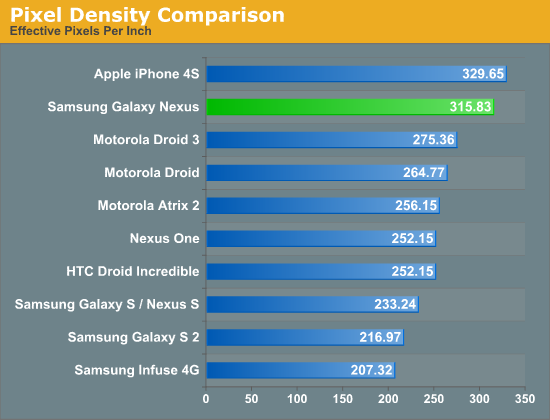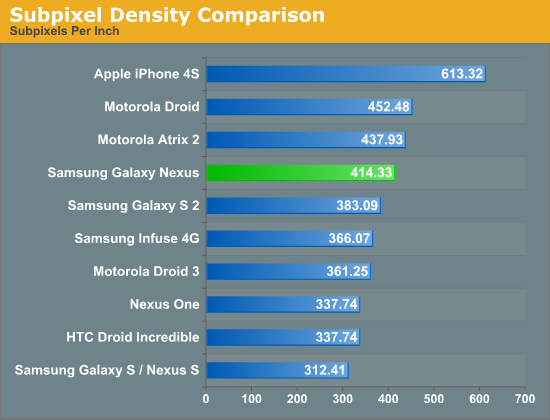Confirmed: Galaxy Nexus Includes PenTile
by Brian Klug & Jason Inofuentes on October 21, 2011 12:58 AM EST- Posted in
- Smartphones
- Samsung
- Ice Cream Sandwich
- Mobile
- AMOLED
- galaxy nexus
Though we've learned a lot about the Galaxy Nexus specifications already, one of the things that has remained a question thus far is whether its 4.65" 720p HD Super AMOLED display uses an RGB subpixel rendering layout or PenTile. We've now confirmed that the Galaxy Nexus display does in fact use RGBG PenTile, like all the Nexus devices to date. This isn't super surprising considering that Samsung has been pretty good about adhering to all the monikers it has gradually been tacking onto AMOLED. There are a number so far - 'super' connotes an optically bonded panel and digitizer stack, 'plus' connotes an RGB stripe, and now 'HD' connotes, well, 720p. HD Super AMOLED lacks Plus, and thus isn't an RGB stripe.
The next question is just what 4.65" HD Super AMOLED will look like, or whether the presence of PenTile will be as noticeable as previous AMOLED phones like the Nexus S / Galaxy S or Nexus One where it was arguably very noticeable. That said, at some subpixel density it should become difficult to impossible to notice PenTile's presence, it's just a matter of exceeding human visual acuity. Having not seen the Galaxy Nexus in person yet and given the absence of good macro shots of the display, we have put together a numerical comparison pitting the Galaxy Nexus panel up against some other common smartphone displays.
First up is a quick plot of the effective pixel density of some popular displays. Stated another way, this is the pixel density based on the manufacturer's stated logical resolution, which is also the resolution of Android's render target for the phone.

Note that this is the traditional means of reporting pixels per inch that we've published before. However, using this metric is just a bit misleading since it doesn't take into account the difference between 2 subpixel-per-pixel RGBG or RBGW PenTile versus the 3 subpixel-per-pixel RGB stripe. To make for an effective comparison, we've put together another plot where we take into account the presence of PenTile and report subpixel density.

Here things still look pretty good for the 4.65" HD Super AMOLED display, putting it just north of SGS2's Super AMOLED Plus display with an RGB stripe. I wager that if you were satisfied with the pixel density of SGS2 that the pixel density Galaxy Nexus actually won't be off-putting despite the presence of PenTile. In addition, hopefully some of the UI design considerations that come along with using PenTile (no vertical 1 pixel thick elements) have been taken into consideration from the outset for Ice Cream Sandwich. For true subjective impressions however, we'll have to wait and see.
Source: Data










152 Comments
View All Comments
smeee - Friday, October 21, 2011 - link
And this is why I read AnandTech, not "thegadgetlife.com.au"...ImSpartacus - Friday, October 21, 2011 - link
No kidding. Even at 1 am, AT is still sharper than the Aussies. Go Team Klug!Gasaraki88 - Friday, October 21, 2011 - link
Yeah, especially when he kept arguing that he's right.miketlo - Friday, October 21, 2011 - link
If it was 800*3 x 480*3 you would have too many sub pixels. The total number of subpixels is 800*480*3 since each pixel has 3 subpixels.By your counting of 800*3 x 480*3 on the same scale 2x2 one inch square you would have this layout:
RGB RGB
RGB RGB
RGB RGB
RGB RGB
RGB RGB
RGB RGB
Since you defined there to be '3 vertical' and '3 horizontal' subpixels per pixel in your definition and the way you counted.
thegadgetlife.com.au - Friday, October 21, 2011 - link
Never mind, I am stupid sometimes, my bad folks :DImSpartacus - Friday, October 21, 2011 - link
Just calculate the area and use that.On a 100x100 grid, you have 10,000 total pixels (i.e. 100*100).
So, there's 30,000 total subpixels (i.e. 10,000*3) on our grid.
So how did we calculate that? (hint: use the parenthesized calculations)
30,000 = 3*10,000 = 3*(100*100)
So, we can use that result to explain the Klugian Method.
3*(100*100) = 3*100*100 = (3*100)*100 = (3*100)x100
If you don't have a strong understanding of area, it can be hard to immediately jump to Klug's explanation.
Then again, if you don't have a strong understanding of area, why are you managing a tech blog? O.o
doobydoo - Saturday, March 17, 2012 - link
Your definition is correct.But it doesn't fit with what Brian actually did.
He took a ppi of 329.65, and worked out a sub pixel density of 613.32.
It should have been 988.95 (329.65*3)
catnaps - Friday, October 21, 2011 - link
You're calculating based on an incorrect assumption. Each pixel is made up of 3 sub-pixels, not 9. Why 9? Because you're including vertical resolution in your calculation, which is wrong because it's not increased- horizontal is.It's really quite a simple concept to get your head around. Back away from your understanding a little and challenge the observations you're making.
Brian Klug - Friday, October 21, 2011 - link
One thing I will say is that this was intended to be a quick means of showing where the display should fall.I believe a clearer way of showing this difference would be to actually compute a weighted sum of the displays, eg
(720*1280/2)*2/3 + (720*1280)*1/3 = 614,400 pixels in RGBG land
as opposed to
(1280*720) = 921,600
and then
614400/921600 = 2/3
which shows exactly the 'RGBG uses 2/3rds the pixels of RGB' line. Then you can do sqrt(2/3) = 0.8164, and then scale each dimension accordingly, eg 0.8164 * 1280 = 1045 0.8164 * 720 = 588, so then the display is "effectively" 1045 x 588.
Then work backwards, to sqrt(1045^2 + 588^2)/4.65 = 257.8 effective subpixels per inch.
The problem is that tackling this either has to happen in subpixels/inch, or pixels/inch. And mixing one up in place of the other makes results that aren't comparable.
-Brian
doobydoo - Saturday, March 17, 2012 - link
If you have a device with a resolution of 1045 x 588, you can't work out the DPI in either pixels or subpixels, using any formula.As I said, you're calculating some weird diagonal in sub pixels, and then dividing it by the screen diagonal.
In fact, knowing the following information:
Horizontal Resolution
Vertical Resolution
Diagonal Screen Size
Is simply not enough to work out the DPI. This is because the diagonal doesn't give you the size of the screen in terms of area. The same length of diagonal can actually represent a smaller or larger surface area. You have to know either the width, the height, or the ratio, before you can calculate the DPI (or the sub pixels per inch).